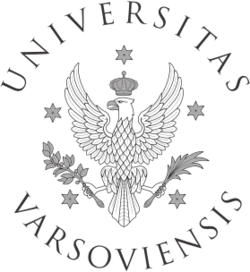Difference between revisions of "University of Warsaw"
(Created page with "{{group |wikipedia=https://en.wikipedia.org/wiki/University_of_Warsaw |logo=POL University of Warsaw logo.svg |constitutes=university |twitter= |start= |headquarters= }} {{SMW...") |
(unstub) |
||
| (2 intermediate revisions by 2 users not shown) | |||
| Line 3: | Line 3: | ||
|logo=POL University of Warsaw logo.svg | |logo=POL University of Warsaw logo.svg | ||
|constitutes=university | |constitutes=university | ||
| − | | | + | |start=1816 |
| − | | | + | |headquarters=Warsaw,Poland |
| − | | | + | |type=Public |
| + | |website=http://en.uw.edu.pl/ | ||
| + | |description=The largest university in [[Poland]] | ||
}} | }} | ||
| + | The '''University of Warsaw''', established in 1816, is the largest [[university]] in [[Poland]]. It employs over 6,000 staff, including over 3,100 [[academic]] educators. It provides graduate courses for 53,000 students (on top of over 9,200 [[postgraduate]] and [[doctoral]] candidates). The university offers some 37 different fields of study, 18 faculties and over 100 specializations in the [[humanities]], technical, and the [[natural science]]s.<ref name="uw.edu">https://web.archive.org/web/20120912055843/http://www.uw.edu.pl/o_uw/</ref> | ||
| + | |||
| + | It was founded as a Royal University on 19 November 1816, when the [[Partitions of Poland]] separated [[Warsaw]] from the oldest and most influential [[Jagiellonian University|Jagiellonian University of Kraków]]. [[Tsar Alexander I|Alexander I]] granted permission for the establishment of five faculties – [[law]] and political science, [[medicine]], [[philosophy]], [[theology]] and the humanities. The university expanded rapidly but was closed during [[November Uprising]] in 1830. It was reopened in 1857 as the Warsaw Academy of Medicine, which was now based in the nearby [[Staszic Palace]] with only medical and pharmaceutical faculties. All Polish-language campuses were closed in 1869 after the failed [[January Uprising]], but the university managed to train 3,000 students, many of whom were important part of the Polish [[intelligentsia]]; meanwhile the Main Building was reopened for training military personnel. The university was resurrected during the [[First World War]] and the number of students reached 4,500 in 1918. By the early 1930s it became the country's largest institution of higher learning. Following the [[Second World War]] and the [[Planned destruction of Warsaw|devastation of Warsaw]], the university successfully reopened in 1945. | ||
{{SMWDocs}} | {{SMWDocs}} | ||
==References== | ==References== | ||
{{reflist}} | {{reflist}} | ||
| − | |||
Latest revision as of 11:53, 14 March 2022
(University) | |
|---|---|
 | |
| Formation | 1816 |
| Headquarters | Warsaw, Poland |
| Type | Public |
| The largest university in Poland | |
The University of Warsaw, established in 1816, is the largest university in Poland. It employs over 6,000 staff, including over 3,100 academic educators. It provides graduate courses for 53,000 students (on top of over 9,200 postgraduate and doctoral candidates). The university offers some 37 different fields of study, 18 faculties and over 100 specializations in the humanities, technical, and the natural sciences.[1]
It was founded as a Royal University on 19 November 1816, when the Partitions of Poland separated Warsaw from the oldest and most influential Jagiellonian University of Kraków. Alexander I granted permission for the establishment of five faculties – law and political science, medicine, philosophy, theology and the humanities. The university expanded rapidly but was closed during November Uprising in 1830. It was reopened in 1857 as the Warsaw Academy of Medicine, which was now based in the nearby Staszic Palace with only medical and pharmaceutical faculties. All Polish-language campuses were closed in 1869 after the failed January Uprising, but the university managed to train 3,000 students, many of whom were important part of the Polish intelligentsia; meanwhile the Main Building was reopened for training military personnel. The university was resurrected during the First World War and the number of students reached 4,500 in 1918. By the early 1930s it became the country's largest institution of higher learning. Following the Second World War and the devastation of Warsaw, the university successfully reopened in 1945.
Alumni on Wikispooks
| Person | Born | Died | Nationality | Summary | Description |
|---|---|---|---|---|---|
| Menachem Begin | 16 August 1913 | 9 March 1992 | Attended the JCIT as Prime Minister of Israel | ||
| David Ben-Gurion | 16 October 1886 | 1 December 1973 | Israel Poland Palestine | ||
| Aleksandra Cichocka | Poland | Academic | An academic | ||
| Hanna Gronkiewicz-Waltz | 4 November 1952 | Poland | Politician Lawyer | WEF/Global Leader for Tomorrow 1994. President of the National Bank of Poland 1992-2001. As Mayor of Warsaw 206-2018, accused of being the main culprit in huge enrichment scheme. | |
| Wojciech Kostrzewa | 18 October 1960 | Poland | Businessperson | Attended the 2022 Bilderberg as President of the Polish Business Roundtable | |
| Vladimir Ivanovich Voronkov | 21 June 1953 | Russian | Diplomat | Russian diplomat. Under-Secretary for the United Nations Counter-Terrorism Office since 2017. |